As an Amazon Associate I earn from qualifying purchases.
If you’re thinking about buying your first piano then you’ve come to the right place. Shopping for a piano is comparable to shopping for a car. You’ll need to look for an instrument that can satisfy your individual needs while also meeting your budget.
Common things to consider will be the size of the instrument, how old it is, the condition it’s in, and ultimately how much of an additional investment needed for restoration efforts.
Buying a piano for the first time can seem like a daunting task, however, it’s quite easy once you know what to look for. With are so many factors that go into purchasing a piano I thought it would be a great idea to put together the complete guide to buying a piano.
This resource will help provide you with all of the knowledge you need to confidently make a purchase. Whether it’s a Steinway, Yamaha, or even a keyboard, the same basic principles will apply.
Want to Learn Piano?Click Here
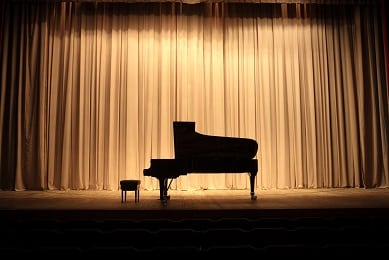
1. Decide Between An Upright, Grand Or Digital Keyboard
Whether your kids are enrolled in piano lessons or perhaps you’re playing the piano as a fun hobby, it’s important to decide which instrument best fits your needs. To start this process you need to understand the 3 main instrument types, their positives, and drawbacks of each.
Digital Keyboard
The lowest possible entry point for a piano is a digital keyboard. Ranging from $100 all the way to $3000, there’s plenty of options to choose from. These keyboards come in all shapes, sizes, the number of keys and more. It’s important that you understand whether your keyboard is semi-weighted vs fully-weighted.
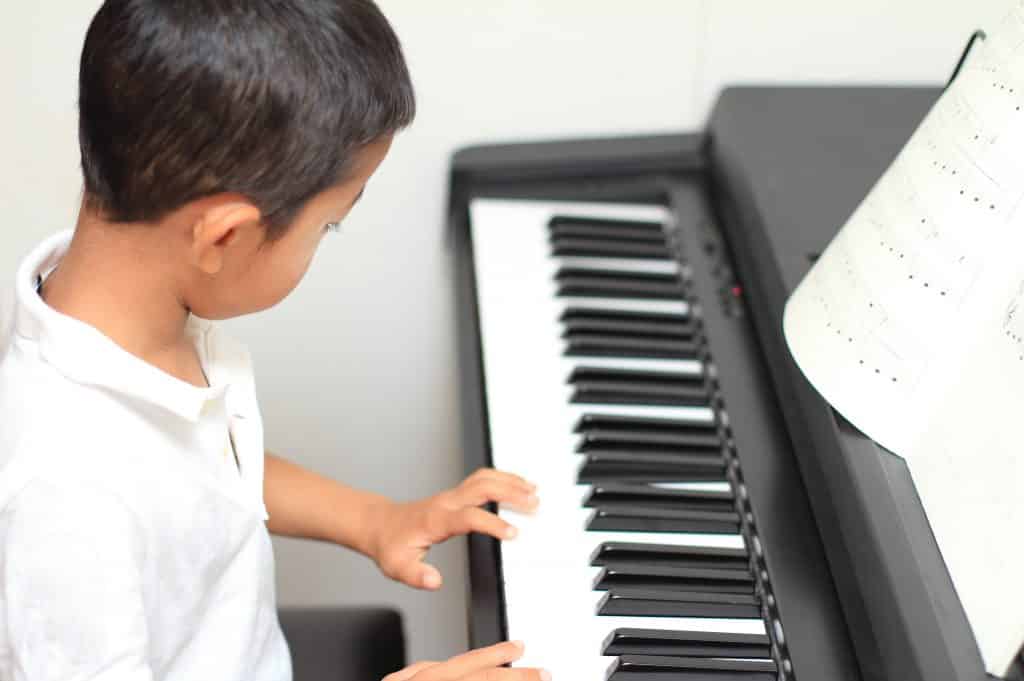
My suggestion to someone looking to purchase a reliable instrument is to go with a solid keyboard console. Something like the Yamaha Arius would be a good choice. Consoles usually come in complete sets instead of needing a separate keyboard stand. Overall it’s a much more durable option for pianists who plan to practice long and often.
The console keyboards usually feature the kind of “hammer action” needed to replicate the touch, resistance and response of an acoustic piano. In addition to touch and feel, portability, and price, digital keyboards offer plenty of entertainment features.
Many of them allow pianists to record themselves playing and also have built-in song banks so you have something to play with. Digital pianos also come with a wide range of authentic sound samples, reverb effects, metronomes, tempo control, and even built-in piano lessons. If you have kids that love to play all the time then the headphones really do come in handy allowing for quiet practice sessions.
Overall I would only suggest a digital piano if you’re on a tight budget. It’s true that these pianos offer a wealth of features, but they’ll never feel exactly like an acoustic piano. Sometimes technical issues can develop from practicing too much on synthetic keyboard hammer action which makes the transition to an acoustic piano difficult.
If you’re tight on space they are definitely more compact than an upright or grand. There’s also little to no maintenance cost associated with these, and depending what kind you purchase you can certainly travel with the instrument. Here’s a list of my favorite digital pianos with weighted action.
Yamaha makes amazing digital pianos, but I would also have a look at Korg, Casio, and Alesis digital keyboards as well.
Upright Piano
I would consider the upright piano to be the median choice. It has a much lower investment point than a grand piano but still offers an authentic touch that keyboards often try to replicate. The average upright piano costs between $5000 – $6000.
Upright pianos are designed to save on space due to their vertical design. For a beginner or intermediate pianist, upright pianos get the job done. They use real hammer action, real copper strings, and are great developmental instruments leading to a grand piano.
The more you invest in an upright piano, the better the sound quality will be. High-end uprights by Yamaha and Steinway are known for their rich tone, responsive action, and durability even in humid climates.
Like a vehicle, upright pianos depreciate in value really quickly, often not able to fetch even half their value. On the other hand, if you’re in the market for an upright then it’s really easy to get a bargain on the used market; sometimes as low as $500.
Grand Piano
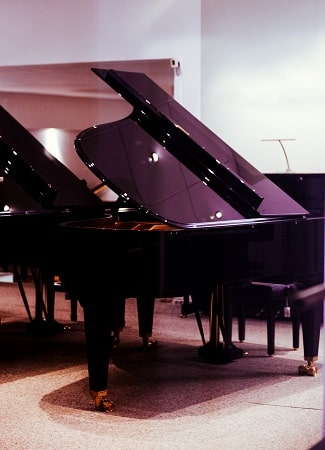
Grand pianos are the cream of the crop, sporting the most cosmetically appealing look out of the three options. One can expect to spend north of $10,000 for a low-end grand piano, but more budget options are being made available.
Used grand pianos are a great bargain, but often need to be inspected (more on this in a minute) to ensure their quality and authenticity. When purchasing a grand piano you should consider the amount of space needed. These are horizontal instruments with the smallest size usually being 5’1″ and going as big as 9″!
As far as touch and tone are concerned, grand pianos are the best. Many are designed to allow for quick repetitious passagework and make piano playing more effortless.
Steinway and Yamaha are considered to be the leading piano manufacturers in the world, however, there is worthy competition out there. Kawaii, Brodmann, Young Chang, and Fazioli are all reputable piano makers that offer better pricing and sometimes better pianos.
Grand pianos are generally going to require more care and maintenance, but they are built tough. Due to their large size, they are also very expensive to move, so do keep this in mind if you’re living in temporary housing. I would only consider this for an intermediate to advanced student who is serious about their craft.
2. Understanding Your Budget
At this point in the piano buying process, you should have an idea of what you want. All of these pianos come in different sizes and have their own benefits. After considering how much noise you want to hear in the home, whether you can fit the piano into a room, and technical development, it’s time to look at what you can comfortably afford.
As I said above, a digital keyboard ranges from $100 – $3000. For a high-quality hammer action keyboard, you should expect to spend around $700 and up. Anything less than that and you are taking a risk of the piano not living up to expectations.
If that is out of your budget then there are a few digital options I would suggest to you. The Alesis Recital Pro, Yamaha P45, and Yamaha P115 are all budget friendly keyboards with hammer action. Many of these also have a separate stand component sold separately to essentially turn it into a console. It may not be the sturdiest option out there, but it is budget friendly and can handle normal wear and tear.

For upright pianos, you should spend at least $5000 so that it’s a high-quality instrument. Often times you can find these on the used market for significantly less. Upright pianos are really inexpensive to move, and most times you can do it yourself with a truck.
Lastly, there is the grand piano which is going to be your biggest investment option. Low-end grand pianos are great for getting by with a beginner, but the more advanced pianist will need something in the $20,000 – $40,000 price range to really do well.
Yamaha makes great low-cost baby grands, and Steinway also has their Boston and Essex pianos as a quality low-cost option.
3. Consider The Maintenance Costs
Before making a piano purchase it’s important to understand the future maintenance costs. If it’s a new piano it may need less work done, but a used or rebuilt piano might need a few extra things done to it. Here’s a couple of common repairs pianos need.
- Tuning
- Voicing
- Pitch Regulation
- Lubrication
- Buffering
- Key Replacement
- Cleaning
That’s a big list, but most of what you’ll need to be done on a consistent basis is the tuning and voicing. Tuning is a good practice because it helps maintain the pitch of the keys and gives your technician a chance to see what else is going on with the instrument. Tuning also keeps the parts firmly fastened so nothing loosens up or falls out of place. A typical piano tuning costs between $150 – $200.
Buffering and key replacements only really need to be done if there was physical damage done to the instrument. Something like bumping into the piano with a coffee mug or dropping a heavy object breaking a key. Those are relatively inexpensive jobs because they can be individually fixed vs tuning where every key is going to be adjusted.
Lubrication is a common job you’ll want to be done to your piano as well. This keeps the keys moving fluidly as you play and is typically administered to the rail pins on the piano keys. Lubrication can also be added to various internal parts of the instrument so that nothing rusts up or loses its freedom of movement.
As far as cleaning is concerned, the most any piano will have to deal with is dust. There are some really great polishes available online, I use the Cory Super High Gloss Polish for my piano. That’s something you can easily do yourself, but most technicians will do this for you for a fee if you ask.
4. Test Playing The Instrument Multiple Times
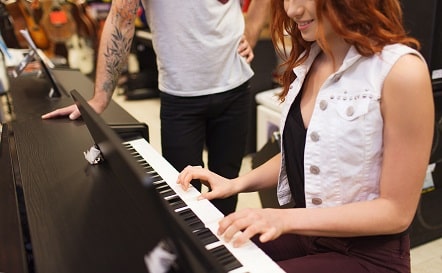
To help make the investment decision easier, it’s important to give your future piano a good test run. I highly advise against purchasing a piano without first playing it. Not just once, but multiple times! Every acoustic, piano has a unique character to it. Steinway, for example, is built by hand, so each piano they produce is completely different.
When testing an instrument here are five things to look for:
How the piano looks
When dealing with a used piano this is particularly important. How a piano looks can tell you a lot about what it’s been through physically. Scratches, dings in the frame and dust filled soundboards could be an indicator of poor care.
On the other hand, you may find a glistening piano with fresh hammers and the original soundboard indicating a quality instrument. This is also a chance to look for any blemishes in the frame as well as any warped areas of wood or changes of material. Buying a piano is a huge investment, so an instrument that’s also visually appealing is an important factor.
How the piano feels
After surveying how the piano looks on the outside, its time to test the touch. Spend a good deal of time playing the keys and seeing how your fingers react to it. Are they smooth and grip well, or does it feel like your hands are sliding all over the place?
Survey the kind of materials the pianos keys are made with. This is a great opportunity to test whether the keys are made with real ivory (pre-1960s) or if it’s using a cheap quality plastic. T
The action of the piano is really what you’re testing here as well, and comparing the resistance of it to another is really important. Often times a piano with light action might feel heavier once another instrument in the room is tested. Spend special attention to the pedals and how responsive those are.
Determine if those pedals require a lot of energy to play and whether the sostenuto pedal is delivering enough dynamic change. Pedals can easily be adjusted in the future, but keys cannot which is why most of your focus should be on the touch, resistance, and responsiveness of the instrument.
How the piano sounds
The sound of your future piano is something to take seriously. All pianos have a different character to them, but you should only buy something that is appealing to your ear. Does a piano with a warmer sound please your ear more? Perhaps you desire the bright percussiveness of a Yamaha C7, or even something less subdued like a Young Chang. This entire part of the process is not something you should do on your first visit.
In fact, I recommend visiting the piano showroom 3 or 4 times so you can get an accurate feel for what the instrument will always sound like. If it’s possible to ask the dealer to move the piano to a different location in the room so you can hear what it sounds like in both an open and condensed setting.
Especially if you have a tiny home the piano may sound different to you once you get it there. Also consider that the kind of flooring in the room, ceilings, soundproofing and more will affect the sound of the instrument.
Take a few moments, pull out a smartphone or portable microphone and record each piano as you play. When you go home you can listen to those recordings and they just might tell you a much different story of what you heard in the piano shop. When I bought my first grand piano I made sure to listen back over several recordings until I found a piano that really caught my attention.
How it compares to other pianos of the same model, make and year
As a general rule, I recommend testing out 5 or 6 pianos to start with. If possible try testing multiple pianos from the same company, and with the same model and build. This is a great way to put all of your options on the table and then eliminate the worse performers.
I’ve mentioned this in the past, but if you’re in the market for a Steinway piano then it’s really important you approach testing them this way. Each Steinway is handmade, so the inconsistencies can sometimes be great. One Steinway model D may play and sound completely different than the one next to it. If you were to just pick one and play it without testing the other, you could be missing out on a better instrument.
With Yamaha’s, this is the case too, but not as much. Generally, their instruments are consistent across the board and they are designed to sound and feel the same. With other brands, it’s important to test all levels of their models. Sometimes you’ll find baby grand pianos might play terribly for one brand, but once you climb into their 7′ and 9′ models there’s a noticeable leap in the quality.
How it compares to less expensive or more expensive pianos
Even if your heart is set on Yamaha, Steinway, and Baldwin, it’s a wise idea to try out some of the cheaper brands. With the advancement of technology and craftsmanship, many of the cheaper pianos are actually outperforming some of the top brands.
Even if you have your mind set on just a few pianos, it’s always a good idea to add in instruments that you would have never considered in the first place. That’s just good common practice to do when instrument shopping.
There’s always a chance that one of those instruments could be the one for you. I remember when I was searching for a piano my mind was set on a Steinway, although I knew I could not afford one.
After playing a Baldwins, Brodmanns, and Hailun pianos I ended up choosing a Brodmann! Not only did I save a ton of money, but the instrument has done wonders for me performing at an incredibly high level since I’ve brought it home.
The moral of that story is to encourage you to have an open mind about the piano you’re about to purchase and think less about the marketing. Also be realistic about where you are in your level of piano study, and always understand that you could upgrade at a later time if you wish to.
5. Negotiating The Final Buying Price
Not everything is set in stone when it comes to purchasing a piano. Most people walk into the store thinking they have to pay top dollar for the instrument. That’s actually far from reality.
Most dealers have pianos marked up high so that they can negotiate with you down to a price that both parties can work with. Even Steinway dealerships are willing to go quite far in talking down the price.
On average you can expect to take an additional 15% – 20% off of the sales price of the piano. Other incentives a piano salesman might throw in are free tunings for a year, free inspections, reduced moving costs, and lower downpayments in order to sell the instrument.
Another great way to talk down the price is if you plan on purchasing multiple pianos. Many dealers will give you a group purchase rate or talk down the overall price to help entice buyers to purchase. Don’t be afraid to ask what discounts are available, or explain how much you really can afford to spend.
6. Getting A Professional To Inspect The Piano

Once you’ve chosen a piano for purchase it’s time to get it looked at by a professional inspector. Piano technicians are those who not only know the in’s and out’s of pianos, but they also have a large grasp on the history of those instruments.
Many piano technicians have actually worked in those same factories building the instruments, as well as tuning and performing maintenance on them in major concert halls.
The one time you really need to focus on getting a technician is when it comes to an instrument that’s had a long history. Any piano that’s 15 to 20 years old should certainly be looked at for quality parts, bad repair jobs, and authenticity.
Used pianos have often times been rebuilt and restored in some sort of way. Some dealers work to replace parts with genuine materials while others will invest in cheaper, less authentic components yet still sell it to customers at a premium value. You see this happen a lot with Steinway pianos being sold as is, but not having the original parts in them that have earned them that reputation.
A good technician can come to the piano store, check the instrument out and determine whether it’s worth your investment. Technicians can also give more accurate and fair instrument appraisals depending if you’re shopping on the secondary market for that instrument too.
7. Getting Your Piano Insured
Much like a car or house, a piano is a huge financial investment that should be fully insured. All kinds of things can happen to the instrument, and sometimes that damage can be irreversible.
Whether it’s water damage, bad repairs, the roof falling in, humidity, theft, and more, it’s always a smart idea to have the piano insured just as you would a vehicle. Most of the time homeowners insurance will cover the instrument if it does not exceed the cost. If not I recommend taking a look at this piano insurance company.
8. Using An Online Vendor
While I highly advocate for playing pianos first before purchasing them, I understand that’s not convenient for everyone. With the rise of e-commerce, more and more piano stores are venturing to online marketplaces to help sell their inventory. This is actually a good thing for customers because it opens up more purchasing options to helpfully locate the perfect instrument for them.
In the past, those in the market for a new or used piano were limited to what was available locally. If the local store didn’t have an instrument you liked then you were pretty much out of luck.
Fast forward to the 21st century and you can now do a simple Google search and bring up thousands of instruments that are available for purchase. Maybe there are no Steinways in your area for sale, but 50 miles away there’s someone selling a used model online.
The downside of purchasing pianos online is the fact that you the customer don’t get an opportunity to play and test the instrument. Often times video clips and sound samples are all you get as far as hearing how it plays.
My recommendation to those taking this route is to make sure there’s is a warranty and trial period for the purchased instrument. Once it arrives at your home, have a piano technician come out to immediately survey the instrument for damage, wear and tear, authenticity, and more.
Next spend a great deal of time playing the instrument, recording it, and letting friends and family hear this as well. If you are not satisfied with the instrument simply return it.
What To Do Next
That’s really all there is to purchase a piano. The entire process is quite easy and most of your concern should be focused on whether it’s the right instrument for you. Spend a great deal of time deciding what type of instrument fits your dwelling the best, and then start narrowing down a budget.
After this start going to several piano showrooms and test their instruments. Take a notepad, bring your smartphone and record and make notes on how each instrument played. Write down the things you loved and the things you didn’t like so much.
Once you’ve decided on a piano figure out how you’re going to pay for it. Do you want to make a big downpayment and take out a loan? Perhaps you’re ready to pay for it in full with cash. Also, see what insurance options you may have available for the new piano. This part of the decision is up to you and what you think your household can afford to do.
After getting the instrument definitely get it looked at by a certified piano technician; particularly if it’s a used or was purchased online with a vendor.
Hello & thanks for stopping by! I’m a professional concert pianist and piano instructor. In the United States, I’ve given successful performances in several places including New York, Florida, Connecticut, & New Jersey, I have also performed internationally in Italy and made my Carnegie Hall debut in 2014. I enjoy blogging about the piano, the art of performance, general music, current events and the latest in music production.
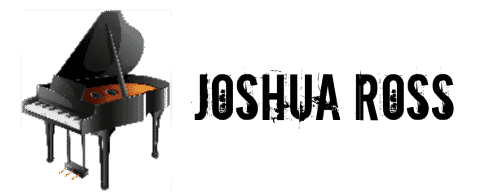
Silas Knight
Tuesday 23rd of April 2019
You've got great tips for buying a piano. I love how you said that it's good to look at what we can afford. It's great to know that upright pianos range around $5000. We're hoping to get a piano like that for our new home, so I'll start budgeting for that!
Upright Piano Vs Grand Piano - Joshua Ross
Thursday 7th of February 2019
[…] lot to consider when deciding between an upright and grand piano. If you plan to purchase one then I recommend looking at this piano purchasing guide. Let’s have a look at what benefits each type of piano offers. We’ll also look at a few […]
Why Are Pianos So Expensive - Joshua Ross
Monday 14th of January 2019
[…] of my own. I researched several brands and found myself wondering why are pianos were so expensive. Knowing how to buy a piano is important because it can help you save money in the long […]
How To Tell If A Piano Is Out Of Tune - Joshua Ross
Wednesday 9th of January 2019
[…] Newer pianos are easier to predict and ultimately will maintain a better tune than something antique. Read my piano buying guide here for more details. […]